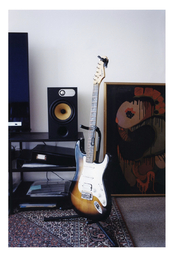Automated XY paper roll cutters are quite expensive, take up a lot of floor space, sometimes have reliability issues, and like other commercial equipment, are complicated and can be expensive to fix. So I'm strictly low tech. My laminated cutting table is about 4 ft by 4 ft, with an equal length dual bar Rototrim cutter attached at one side. There is a stainless steel squaring bar attached to one side of the table at exactly 90 degrees. Then a second stainless bar is placed across the table at predetermined paper length positions, with threaded inserts into these locations accepting non-scratching teflon thumbscrews. Just below the cutter bar is a pair of adjustable cones which receive the paper roll, in combination with a couple other roller rods allowing me to manually feed the paper under the standard retaining sleeve and onto the table.
This table works great for trimming all sizes of prints and mounting tissue in daylight. But it took quite a bit of practice to handle big heavy Fujiflex rolls in the dark.
It's not like paper. There's a fair amount of spring to it, all coiled up. I have a non-marring long accessory weight nearby to place over the paper when it's in the correct position, prior to pulling the cutter itself down the alignment rods. I don't use any safelight, except to keep a tiny little Jobo Minilux available in my pocket for momentary emergency use if needed. Other tables hold various paper safes: 30X40 inch, 20X24 inch, and 8x10 inch for test strips cut down from leftover pieces.
The really nice thing about Fujiflex is that it isn't electrostatic like Cibachrome was, which attracted dust, and is also far more resistant to dents, creases, and scratching; that's why they named it "Flex". Ans on the enlarging table it lies so flat that a vacuum easel is seldom even needed. Great product. Ektar film and Fujiflex is a marriage made in heaven. And of course, like other RA4 chromogenic media, it prints in just a fraction of the time once needed for Ciba. Fuji's batch to batch control is also quite consistent, and the paper keeps well for several years unless it's hot or humid.
As for your specific question. Yes, with a greater hue gamut, Fujiflex can reproduce more range than ordinary RA4 papers like Endura. But the name of the game is matching the negative contrast range to that of the print medium itself. That is done by digital curve adjustment in commercial laser mode. But in darkroom printing, you either want to find a film which corresponds to your expectations at a certain magnification, and/or learn supplemental contrast masking (highly recommended if you're going to get serious about this). Ideally, make big prints by enlarging large format film. And yes, you can make prints even superior to Ciba in this manner.
But it takes awhile to rethink what color neg film can do. I've already dropped a clue - Ektar.












